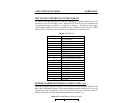
MFJ-1278B MULTI-MODE TROUBLESHOOTING
Step 1: Power Supply
The first thing to check in any malfunction is the power supply. Check the power supply
levels at the outputs of the voltage regulators, Q2 and Q3 as well as the output of the inverter
(U2). Are they close to their nominal values? Do all the ICs in the suspected area have the
proper voltage on their power pins? Is there a voltage return path, ground on the ICs ground
pin? Is there excessive ripple in any of the DC voltage lines? If so, check the regulator and
associated components, working backwards toward the input power switch. If the voltage is
low, in conjunction with a hot regulator, suspect a short circuit on the board.
If the problem is in the -5 volt supply, work backwards from Q2's collector (also at U16 pin
1), that should be -5 volts regulated, to the junction of C9 and CR2 (-V unregulated). If no
voltage appears at -V, then U2 or a related component may be at fault. Verify that U2 is
oscillating by looking at the wave form at U2 pin 5. If -V is more negative than - 7 volts (i.e.,
normal), but the -5 volt regulated voltage is wrong, check the negative regulator components
U3, Q2, R5, R6, R7, R8, CR6, C10, C11 and C158. If both -V and the -5 volt regulated
voltage are wrong, look for shorts.
Step 2: Obvious Problems
CAUTION: A word of WARNING here. DO NOT touch any component that is suspect of
being HOT. This could result in BURNS from the HOT component. If you have never left
finger prints on top of an IC, it is an experience you will not soon forget.
Look for any unusual physical symptoms. Are any components discolored? Does something
smell burnt? Do any of the parts seem excessively warm? If you have never had your fingers
on operating digital integrated circuits before you may erroneously conclude they are too hot
when they are actually operating normally. Take for instance, the Z80 CPU and the Z80 SIO.
They generally are warm to the touch. In general their normal temperature will be well below
the boiling point of water, but you may not want to keep your finger on them very long.
Step 3: Assembly Problems
Carefully inspect the PC board and component installation. Are any cold solder joints
present? Is a metal screw shorting to the board anywhere? Are all ICs firmly seated in their
sockets? Are any IC leads tucked under the chip or otherwise bent in such a manner that they
are not making proper contact with the IC socket?
Inspect the diodes and electrolytic capacitors for proper installation. Are the diode cathodes
pointing the correct way? Are the negative ends of the electrolytic capacitors pointing the
correct way?


















